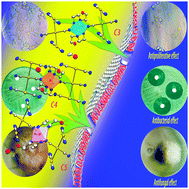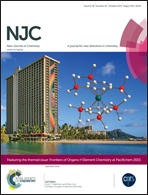Five novel dicyanidoaurate(i)-based complexes exhibiting significant biological activities: synthesis, characterization and three crystal structures†
Abstract
Five new cyanido-bridged coordination polymers having closed formulae [Ni(hydeten)Au2(CN)4] (C1), [Ni(hydeten)2Au2(CN)4]·H2O (C2), [Cu(hydeten)2Au2(CN)4]·CH3OH (C3), [Zn(hydeten)2 Au2(CN)4]·H2O (C4), and [Cd(hydeten)2Au2(CN)4]·H2O (C5) (hydeten: N-(2-hydroxyethyl)-ethylenediamine) have been prepared and characterized by elemental, thermal, FT-IR and XRD (C3, C4 and C5) measurement techniques. The anticancer, antibacterial and antifungal activities of the complexes are also investigated. The C3, C4 and C5 units according to XRD analyses are linked to each other via –CN–M(hydeten)–NC–Au(1)–CN–M(hydeten)–CN– chains (MII = Cu, Zn and Cd) and aurophilic interacted –Au(1)(CN)2–Au(2)(CN)2–Au(1)(CN)2–Au(2)(CN)2– zig-zag shaped chains along the a axis. C1, C2 and C4 show significant antifungal effects against several plant pathogenic fungi, while surprisingly C3 exhibits a considerable antibacterial effect against Gram negative E. coli. The studies of the antiproliferative activity on Hela, HT29 and C6 tumor cell lines indicated the anticancer potential of these complexes even at low doses.


 Please wait while we load your content...
Please wait while we load your content...